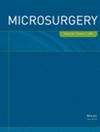Use of the pedicle of previously harvested pectoral myocutaneous flap as a recipient for free flaps in head and neck reconstruction
Abstract
Introduction
The pectoral myocutaneous flap (PMF) is a workhorse regional reconstructive option for head and neck defects. It is commonly used for primary reconstructions due to its advantages or as a life-boat flap in the salvage of failed reconstructions of free flaps. However, it also has intrinsic drawbacks, such as perfusion problems and partial or complete flap loss. Although there are many studies about the advantages and use of PMF in the literature, the number of studies about salvage of this workhorse flap is inadequate. We aimed to present the use of the pedicle of previously performed PMF as a recipient for free flaps in head and neck reconstruction.
Methods
Between January 2022 and August 2023, 10 free flaps were used in nine patients (three females and six males) who had previously undergone head and neck reconstruction with PMF. The age of the patients ranged from 54 to 74 years. Seven out of the nine PMFs were previously performed by different surgical teams. Squamous cell carcinoma (SCC) was the reason for primary surgeries in all patients and the PMFs were used for right lower lip and right submandibular defect, left lower lip and mentum defect, lower lip defect, right lower lip and right submandibular defect, right retromolar trigone defect, right buccal defect, left anterolateral esophageal defect, right retromolar trigone defect and left anterolateral pharyngoesophageal defect reconstructions. The problems were partial skin island necrosis and wound dehiscence in six patients and total skin necrosis in three patients. The partial skin island necroses already showed that the pedicles were unproblematic. For patients with total skin island necrosis the muscle stalks so the pedicles were also unproblematic which were confirmed by physical examination and Doppler device. After complications, the finally defects were located in the lower lip, left lower lip and mentum, right lower lip and right submandibular area, left anterolateral esophageal area and left neck, right buccal area, right retromolar trigon, left anterolateral pharyngoesophageal fistula and left neck. The sizes of the defects were between 3 × 4 cm and 11 × 17 cm. For all patients, the pedicle of the previously harvested PMF was used as a recipient for free flaps. Since the PMF was flipped over the clavicula for the reconstruction previously, the pedicle was so close to skin or skin graft which was used for coverage of the muscle stalk. The Doppler device was used first over the clavicle where the PMF was flipped for vessel identification. After marking the vessels, a vertical zigzag incision was made on the skin or skin graft. The perivascular fatty tissue and the pedicle were encountered with minimal dissection by the guidance of Doppler. After meticulous microscopic dissection, the pedicle of PMF was prepared for anastomoses as usual. Six radial forearm free flap (RFFF) and four anterolateral thigh flap (ALT) flaps were used in the head and neck reconstructions for the nine patients.
Results
The sizes of the flaps were between 4 × 5 cm and 12 × 17 cm. The diameters of the recipient arteries were between 0.9 and 1.2 mm. Recipient veins were approximately the same diameter as the arteries. In one patient, two vein grafts were used for lengthening both the artery and vein to reach recipient vessels. End-to-end anastomoses without vein grafts were performed in the remaining patients. One arterial thrombosis that manifested on the first postoperative day was salvaged successfully. Hematoma was seen in two patients and wound dehiscence was seen in three patients. There was no partial or total flap necrosis and all flaps survived. The follow-up period ranged from 2 to 12 months. Despite successful reconstructions, two patients died during the follow-up period due to unrelated conditions. Functional results were acceptable in the remaining patients.
Conclusion
The pedicle of previously used pectoral myocutaneous flaps may be a useful alternative option as the recipient for free flaps in head and neck reconstruction.

 求助内容:
求助内容: 应助结果提醒方式:
应助结果提醒方式:


